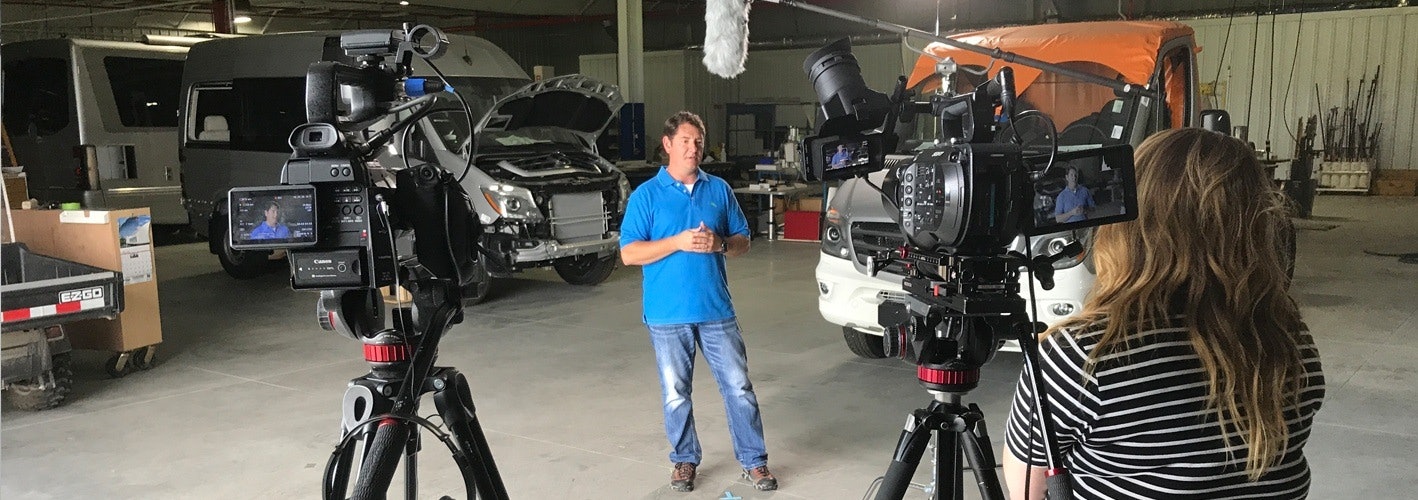One-third of online activity involves watching videos. Considering teenagers alone spend roughly 27 hours a week online, one-third is a massive amount of time.
It’s no wonder marketers are investing in video.
But this isn’t news to us—we’ve been reminded that it’s a big deal year after year after year.
My theory for why video will continue to be a hot topic? Because many brands, companies, and organizations still don’t know what the heck they’re doing, how to use video effectively, and how to measure and evaluate the success of their video marketing efforts.
But hey, I’m not trying to be pessimistic. It’s not easy. If it was, we’d have already mastered it, and moved on to the next big thing (AR? VR? AI?).
As a washed up film major turned content marketer, thinking about the role video plays in the success of an organization’s marketing is fun for me. I think it can be fun for you, too. So let’s get to it.
Why Video Marketing?
What’s the deal with video? Is it really that great? The short answer is yes—when done right.
For one, video marketing statistics are hard to ignore. Blog posts incorporating video attract 3x as many inbound links as blog posts without video. Half a billion people watch a Facebook video every day. Marketers who embrace video grow revenue 49% faster than their non-video counterparts.
In reality, video is simply a medium of content that engages, educates, entertains, and inspires people at alarmingly high rates. And better, it’s content that people like.
But, as with all other types of content, video needs a strategy or you’re just mindlessly throwing things together, unsure if it’s all making a real impact. So here’s some advice for putting together a great video marketing strategy, and what you’ll need to do before you ever start rolling the camera.
Step #1: Define Goals / Figure Out What You’re Trying to Achieve (and for Whom)
First and foremost, you need to set goals for what you want your videos to accomplish. Please don’t create videos merely for the sake of creating videos. Just like you shouldn’t add content to your website simply because you think that’s what good marketers do, don’t invest time, energy, and money into a video that inevitably has no impact.
When defining your video marketing goals, you’ll need to take the following into account.
Purpose
Your video needs a purpose or a problem it’s trying to solve. If it solves a problem tied to a business result, even better. On top of that, in my opinion, videos should actually have two goals—one that’s business-driven and one that serves the audience it’s trying to reach.
Let’s look at an example.
Pretend you’re an e-commerce company selling fashionable sunglasses that’s looking to improve product page conversion rates. Your customer service team constantly gets phone calls regarding the fit of your shades. You decide to test whether or not adding a product video could increase conversion rates on these pages.
In this case, the purpose of the video serves both your audience (they want to see what the product looks like on a real, human face) and business (fewer phone calls for your customer service team, higher conversion rate).
What Defines Success
This should go without saying, but you need to have some idea of what success looks like. Even if it’s too early in the process to have real, hard numbers, you should be able to define which part of the business it’s going to improve, whether it’s organic traffic, conversion rate, brand awareness, or something completely different. This goes hand in hand with defining the purpose, or the “why are we even doing this?” part of the video process.
Audience
Like most companies, you likely have multiple audiences that you’re marketing to. It’s your job to determine which one your video should focus on.
Going back to the previous example, let’s say that this e-commerce sunglasses brand serves multiple audiences, one of which is the fashionista and another that’s looking for quality, low-cost shades. As you could imagine, a product video might look different depending on the audience you’re trying to hit.
For the fashionista, you might consider having an actual person model the sunglasses. There might be upbeat music and you could get angles of the sunglasses on top of the model’s head, something the fashionista might be concerned about. For the other audience, you might focus on reliability, showing up-close details of the screws, polarized lenses, etc.
Long story short: your video needs to have an intended audience in mind before you start shooting. And keep in mind that audiences can range from the people using your product and service to recruitment and internal talent.
Budget
When planning your video marketing strategy, you also need to think about budget. I’m not just talking about production cost, but rather time, effort, personnel, and even video marketing technology.
If you don’t have a huge budget, don’t fret—just have a good idea. In college, I had a screenwriting teacher who bluntly told us something along the lines of “you can make great movies with a small budget, but the biggest budget in the world can’t save a terrible idea.”
I feel the same way about video. Most videos that suck, suck because the idea isn’t good. Yes, production value matters, but what irritates me more than anything is wasting a ton of money producing something that never had a chance in the first place because the idea, goals, strategy, and messaging were all wrong to begin with.
End of rant.
Step #2: Think About What Type of Video(s) You Need to Create
Now that you have an audience to target, a reason to create the video, a vision of success, and a budget in mind, you and your team can start actually thinking about the substance of the videos. Fun!
Content Topics
My advice for researching video topics? Go about it in a similar way that you would for any other blog post, webinar, etc.
For me, I think it’s helpful to look at your competitors, do some keyword research, check out Buzzsumo to see what kinds of topics your audience engages with through social channels, talk to your customer support or account teams to figure out what kinds of questions people are asking, and maybe even stalk a few LinkedIn groups.
Don’t overthink it. Video is really just content, after all.
Types of Video
Another thing to think about is the type of video or videos you need to create. Are they going to be educational? Customer stories meant to inspire? Do the videos need to drive a conversion?
When marketers hear the words “video marketing,” they often throw everything they know about content out the window and assume that people will pay attention to a video because, well, it’s a video and the statistics tell us people watch them. In reality, you shouldn’t assume that people will watch something that’s not, at the very least, useful to them.
That’s not to say that they have to be boring. Headspace actually does a really good job at creating educational animations that are engaging, brand-building, and, most importantly, helpful. I’ve included my favorite one below because…well, just watch it.
I know it can be tempting to create flashy, commercial-like videos. And if they’re going to be shown on TV (and are, in fact, commercials), go for it. But creating videos that have no strategy or search value that will inevitably gather digital dust on your YouTube channel generating five views per month probably won’t give you the return you’re looking for. (But again, if you clearly define the purpose, goals, audience, etc., you shouldn’t run into this problem in the first place!)
Step #3: Align Your Videos to the Buyer’s Journey
At E3, we make an inventory of all our content and map it to the buyer’s journey. We look at which pieces of content target which part of the funnel and which audience or buyer persona. This allows us to see where the content gaps lie, and where we’re running thin.
When creating a new video or video series, you need to think about the content in the same way, and place it within the buyer’s journey. If the video’s purpose is to drive organic traffic for new users who have never been to your site, think about the video from a top-of-the-funnel point of view. Like other content at the top of the funnel, it should probably be focused on what people are searching for.
On the other hand, if you’re creating a video to engage current brand evangelists or those in the consideration stage, maybe you focus on earning their trust by showcasing customer stories and featuring those in your community.
While I won’t get too detailed, this article does a good job at overviewing types of video and how they fit into the buyer’s journey. But essentially, it looks a little something like this:
The Marketing Funnel and Video Types
- Awareness Stage: Brand films, animation videos, educational videos, video documentaries, how-to videos, 360 experience videos
- Consideration Stage: Product videos, company culture videos, testimonials, video PSAs
- Decision Stage: FAQ videos, product demonstration videos, personalized videos
We actually used the buyer’s journey as inspiration for a video campaign we launched for one of our clients, Airstream. As you can see, Santa actually follows the buyer’s journey as the campaign progresses. You can check out the full case study here.
Step #4: Plan the Work, Work the Plan
Just because you know what type of video you need, the problem you’re looking to solve for the business and for the audience, and the part of the funnel the video should address, that doesn’t mean you’re done planning just yet!
This is the part of video marketing that requires you to think like a digital strategist—considering how you’ll reach the audience, which channels are appropriate, where the video will live, how it fits into an overall campaign, and how you’ll measure and track the video’s success at the end of it all.
Here are some questions to keep in mind when creating your video marketing strategy:
- Where does the video live and what software do we need to make this a reality?
- Which channels will we use to promote the video?
- How are we measuring video interactions (click-through rates? Time watched? Conversion rate?) What does success look like more specifically?
- Does the video timeline make sense?
- How does this video fit into the overall marketing plan or content strategy?
Once you’ve answered these questions, it’s often helpful to place them within a blueprint, especially if you’re launching a large-scale campaign. Lucky for you, we launched a webinar that can help you communicate how everything fits together.
At the End of the Day, Treat Video Like the Rest of Your Content—with Intentionality
As a marketer, it’s your job to guide the video marketing strategy. Whether the team creating the final product is an agency or your in-house team, it’s up to marketers to define goals, figure out how to measure success, and craft a plan that delivers the video to the right audience in the right channel at the right part of their buyer’s journey.
Video is a powerful medium that has the ability to teach, inspire, educate, entertain, and engage. But when it comes down to it, it’s just content. And you’d better believe you need a strategy to drive real, meaningful business results.






